1988 Mexican Grand Prix race report
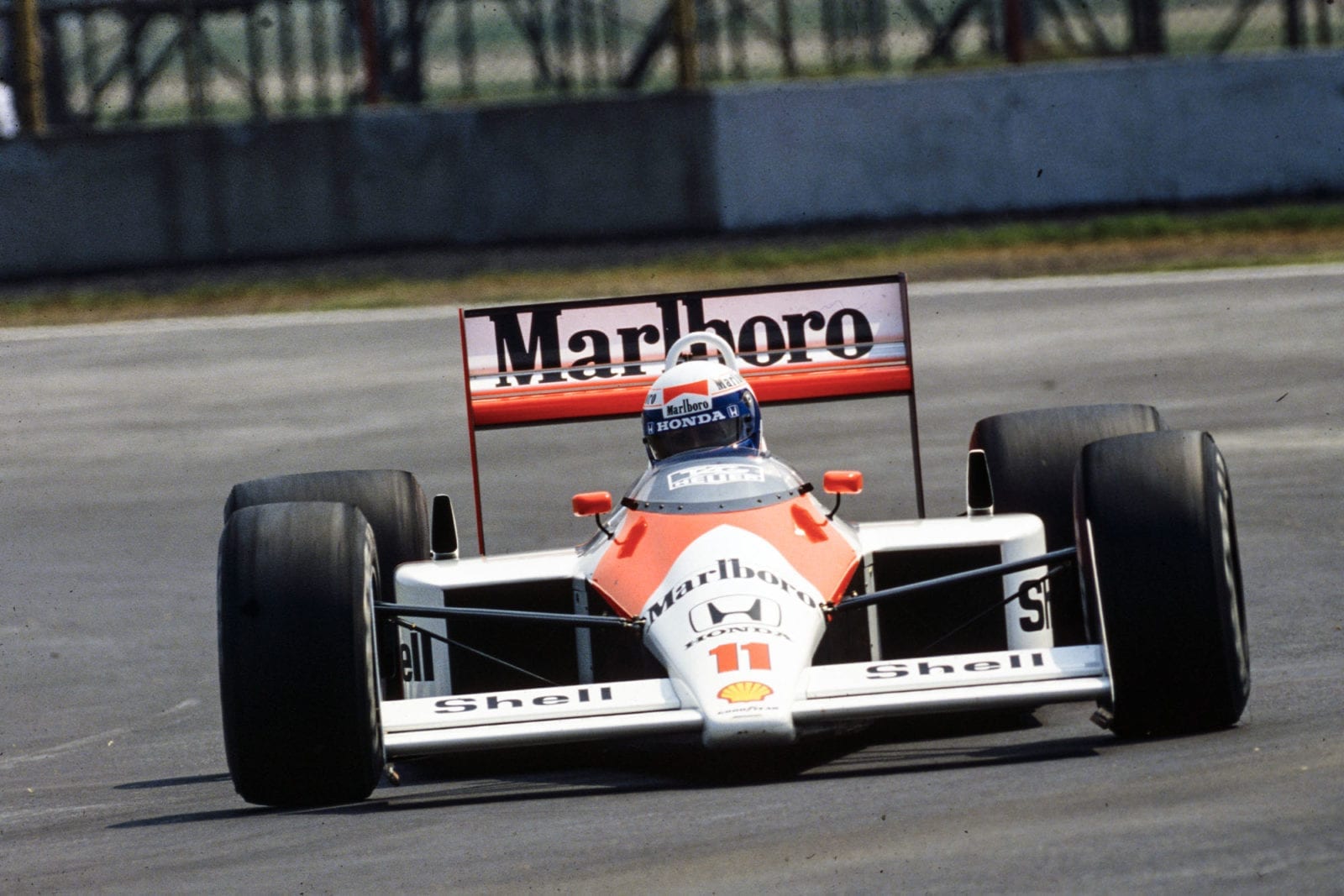
McLaren's Alain Prost claimed his third win from four races
Motorsport Images
Two burning questions emanated from an otherwise dull Mexican Grand Prix. Both concerned Ferrari and Gerhard Berger. Might he have got on terms with Honda Marlboro McLaren if he had made a better start? And might he have been able to exert late-race pressure on overheating winner Alain Prost if his F187 hadn’t given him spurious fuel read-outs which obliged him to ease his pace after the halfway mark?
In a race most remarkable for the fact that Prost defeated team-mate Ayrton Senna in what to all intents and purposes was a straight fight, it was the what-ifs and maybes that created the real interest.
Free practice on Friday morning initially suggested that both Ferrari and Lotus had made some progress since Monaco. The former had internally revised engines with butterfly-valve protection against lift-off overboost, similar to the system which the Honda drivers have enjoyed since Imola. The latter had further revised suspension geometry and modified damping.
Berger, in particular, was right on the pace with a 1min 19.988sec effort which put him in McLaren’s ballpark. Scant, predictably, was fastest on 1min 19.475sec, with Press managing 1min 19.803sec. You wouldn’t have known it, to look at the manner in which the red-and-white cars flowed over the Autodromo Herrnanos Rodriguez’ notorious bumps, but neither driver felt he had achieved an optimum chassis set-up, nor would for the majority of qualifying.
The Austrian was cautious when quantifying any improvement in his Ferrari’s performance. “What you have to remember is the effect of altitude here. It adds a variable to any assessment of the revised engine. I reckon we should know for sure just how much progress we’ve made by the Canadian Grand Prix.”
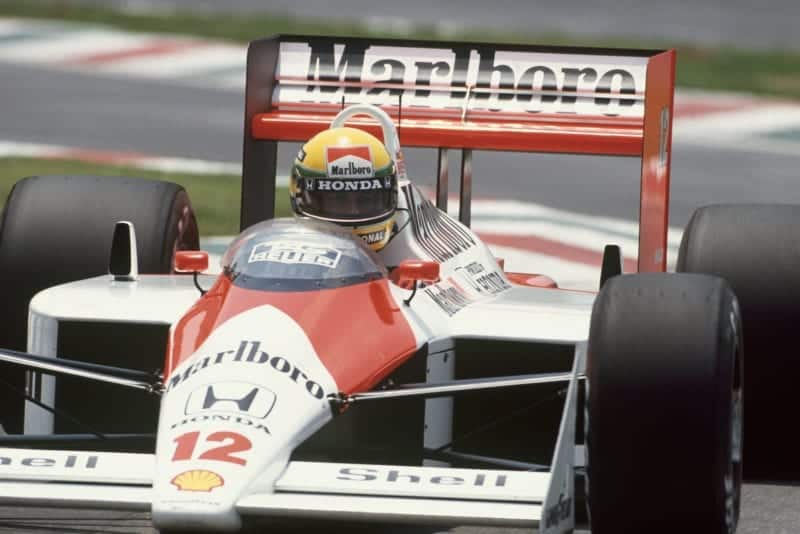
Ayrton Senna took pole for McLaren
Motorsport Images
Nevertheless, Ferrari insiders calculate the gap to the Hondas has been reduced to around 35 bhp, and with new pistons due to appear in Canada, there was an air of optimism permeating the team. That is despite some fearsome political infighting taking place back at Maranello, where Il Commendatore was threatening to exile his son Piero Lardi Ferrari from his position with the racing team, to one on the road-car side.
The remainder of qualifying, however, proved a case of the gifted Senna continually moving the goal posts whenever his best lap came under challenge. With track conditions at their best on Friday afternoon, he finally worked down to a staggering 1mm 17.468sec, way below Nigel Mansell’s 1987 pole time in the Williams Honda of 1min 18.383sec despite the 1988 cars’ reduced power. Prost, however, was not far away, matching his every move at one stage.
When Senna’s best was 1min 18.088sec, the Frenchman carved down to the 1min 18.097sec lap which would earn him his grid position, but thereafter his challenge for pole was hampered by incorrect damper settings.
With an overnight storm washing away much of the accumulated rubber on the surface, Saturday’s times were marginally slower, Senna managing 1 min 17.666sec and Berger a mighty impressive 1min 18.120sec as Prost struggled slightly with a faulty pop-off valve.
Thus became apparent the progress Ferrari had made even since Saturday morning’s free practice, the Italian car’s chassis every bit as good as the McLarens’ on handling and also strong on maximum speed. Only the McLarens’ excellent traction seemed to swing the balance.
In the Lotus camp, meanwhile, Gerard Ducarouge has come to the conclusion that the 100T’s traction, its mechanical grip, is its Achilles Heel. Unlike McLaren, Lotus didn’t have the budget to initiate a new gearbox programme to take full advantage of Honda’s lower RA-168E engine. Thus, whereas McLaren has its lowline MP4/4, so reminiscent of the Brabham BT55, and its ingenious three-shaft gearbox which effectively steps down the powerline, Lotus is stuck with its angled gearbox and a less than optimal centre of gravity.
Certainly the 100T lacked nothing in manimum speed, being as competitive as the Ferraris and McLarens in that respect. While Berger closed the qualifying gap to the McLarens however, Piquet, despite attack mode on a circuit he loves, could only just squeeze beneath the 79-second barrier with 1 min 18.946sec. Nevertheless, it was a sign the Hethel team is moving in the right direction.
After a practice accident that befell Philippe Alliot in the Larrousse Calmels Lola, Senna lined up on pole on the right-hand side of the grid, faced by a patch of cement-dusted oil only yards ahead. That delayed him only slightly, but a prematurely opening pop-off valve really killed his chances as Prost surged ahead and Piquet got an absolute flier to challenge for the lead on the outside down to turn one. Prost held steady — just — but Piquet slotted in second ahead of Senna, as Lotus team-mate Satoru Nakajima, sixth fastest in qualifying, pushed ahead of Berger and Michele Alboreto in the second F187.
With Piquet holding Senna back, Prost made the most of the opportunity, and that opening lap set the cast for the remaining 66. Prost’s first lap took him 1 min 31.240sec, Senna’s 1min 33.527sec. The latter boiled past Piquet even before they turned in for the banked right-hander at the end of the lap, but already the damage was done and Prost was nursing a 2.3-second advantage.
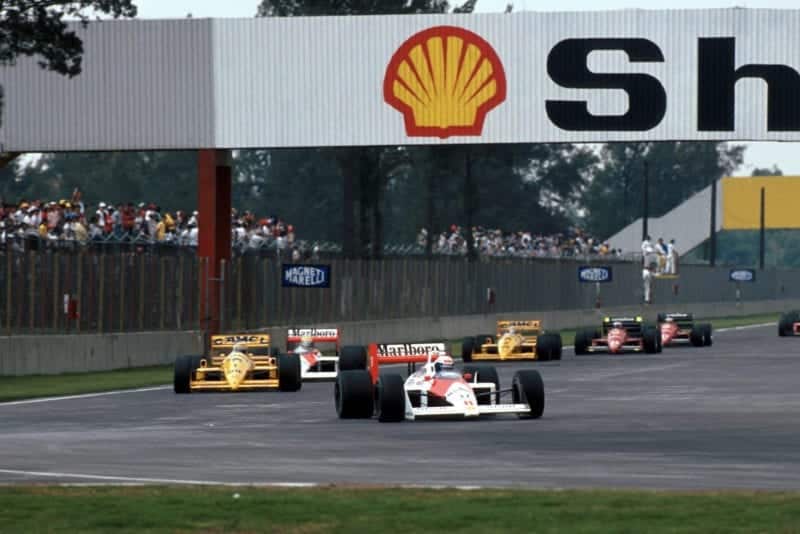
Prost leads at the start
Motorsport Images
Two years ago in the Mexican race, Pirelli-shod Berger won without a tyre stop as the Goodyear runners all made two, except the canny Prost who got by on two sets of tyres. This year, the same Goodyear-damaging understeer was a very real possibility in those early stages, so the Frenchman again played it cool, going only as fast as he dared.
Senna, meanwhile, pushed a fraction too hard in an effort to close the gap. He suffered sufficiently serious tyre-wear to consider pitting as Berger, having finally passed Nakajima and Piquet, closed to within three seconds in a charge that reaped him temporary fastest lap on lap 25.
Senna’s pop-off valve was again opening unexpectedly every so often, obliging him to wind down the boost, but understeer was his main concern. As Berger homed in, he seriously considered that tyre stop “because in trying to compensate for the understeer I had also blistered my rear tyres. There was nothing I could do to stop Gerhard hauling up on me.”
Just as Senna was prepared to concede second place to the Ferrari, however, Berger decided enough bravado was enough. Since the beginning of his charge his fuel read-out had been showing him a minus, and “I knew all along, I’d have to slow eventually. No fuel, no finish! It’s as simple as that!” Sadly, it was even simpler. Post-race inspection revealed that the Ferrari had ample fuel left, the read-out having given faulty information . . .
Prost, consistently the fastest, cruised on, his initial worries about understeer being negated as more rubber went down as the race moved into its second half. As his tyre-wear problem thus receded, he became more comfortable, until his engine water-temperature began to edge dangerously high towards the end.
Despite that, he reeled off the final laps to take his thirty-first career win his twenty-second for McLaren — in a manner which answered the Monaco critics who suggested he would never beat Senna in a fair fight. He had, and he had done it with all his usual style. He had also done it earlier in the season than many had expected.
Ayrton, meanwhile, had more to worry about as he headed to the flag, as his McLaren was right on its fuel margin. Normally the Brazilian is supremely economical, and he and team engineer Steve Nichols wore worried expressions immediately afterwards. Had Berger still been in a position to push with a healthy Ferrari, we might just have had some late race sensation . . . Heaven knows, it would have been welcome.
There were other good cars in the Mexican GP, quite a number of them, but none looked remotely like challenging the top three.
Piquet, after his excellent start, found he could match neither the McLarens nor Berger. The Brazilian’s best lap was actually faster than Berger’s but, once past, the Austrian pulled away. Nelson was confident he could hold Alboreto at bay, however (even though the Italian worked close on two occasions) and was demonstrating the fact when his engine expired suddenly as he crossed the line to start his 59th lap. Nakajima, meanwhile, having fully exploited his turbo’s advantage 7500ft above sea level, retired from the best race of his Fl career with turbocharger failure after 28 laps.
Alboreto thus finished fourth, a lap down, having once again been beaten by his team-mate. There are those who feel the Italian either to have lost his edge or to have met more than his match in Berger, but those who recall drives such as that at Monaco in 1985 find either hard to believe. His best lap was very little slower than Berger’s and as his relationship with the Prancing Horse steadily winds down, he for one is convinced he is not receiving quite the same treatment.
In this dull encounter, principal interest came courtesy of the Arrows drivers, Derek Warwick and Eddie Cheever. The Englishman was initially the faster in qualifying until he ran into engine and fuel metering-unit troubles on Saturday, whereupon Cheever emerged to put behind him the embarrassment of a harmless spin into the gravel on Friday.
He started from seventh slot with Warwick ninth, and up to lap 26 they were at it like a couple of Formula Ford drivers, Cheever’s car understeering and running less than full boost, Warwick unable to get right under his rear wing ready for the run down the main straight. Then Cheever was tripped up behind a backmarker and Warwick got a good enough run at him to snatch the place.
Thereafter, the roles were reversed, and by now Warwick too was troubled by fluctuating boost-pressure and a loosening undertray. On lap 50, running down the main straight, he was baulked by Oscar Larrauri in the EuroBrun, and Cheever got a solid enough run at him to draw alongside on the outside down to turn one. For a moment they all but touched, before the American had to slot back in behind his team-mate, and there he stayed to the flag.
On the slowing down lap he tangled with Larrauri and despatched him into the gravel bed, later being asked to attend a stewards’ meeting to explain his conduct. He also gave the Argentinian driver a fair chunk of his mind in retaliation for what he felt to have been excessive baulking as he recovered from his unsuccessful move on Warwick on lap 50.
If both drivers enjoyed their dice, Jack Oliver and Alan Rees were rubbing their hands after another reliable outing, and though the A 10Bs still can’t feed fully competitive pace, they can at least stay the course.
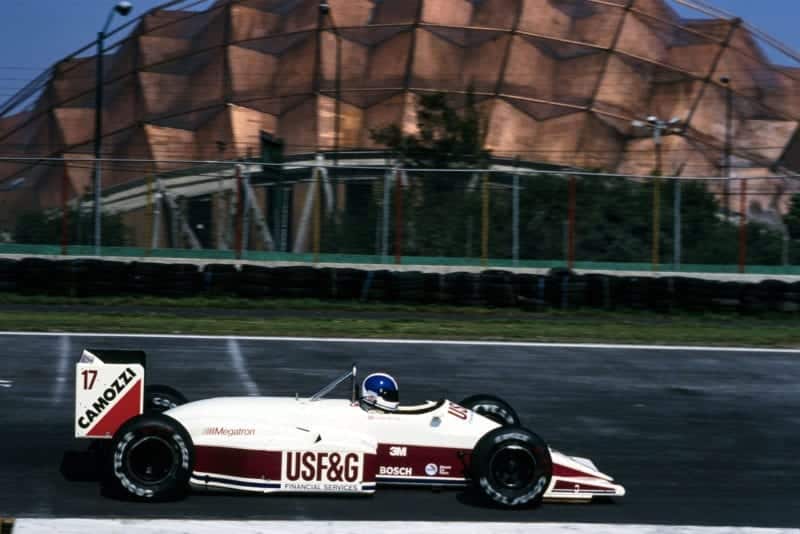
Derek Warwick scored two points for Arrows
Motorsport Images
Likewise the Benettons, which followed them home in eighth and ninth places in the hands of Alessandro Nannini and Thierry Boutsen. Rather like Berger with Alboreto, Nannini is emerging as the star in this team, and the chain-smoking Italian was simply brilliant in qualifying as he planted his B188 on the outside of the fourth row with 1 min 20.740sec. Much further down the grid, Nigel Mansell expressed the envious view that the Cosworth DFR must be producing over 600 bhp if the Benettons’ straightline-speed and acceleration were anything to judge by.
Certainly the Rory Byrne-designed chassis were coping well with the bumps, and though both drivers experienced their usual share of niggling qualifying problems, they easily outpaced their normally-aspirated opposition. Boutsen slipped ahead of Nannini for laps two and three before dropping back, troubled for the rest of the race by understeer and a braking imbalance, Nannini, meanwhile, lost his helmet support-strap early on and found life uncomfortable as a result.
Worse was to come. At Imola he had been in great pain from the nerves in his right foot, and in Mexico the problem was even more acute. “It was so bad I was crying in the car,” he admitted afterwards, at least satisfied he’d made up for a faux pas when he stalled on the grid at what should have been the first start, and caused the race to be restarted and run a lap less than its scheduled 68.
The big story in the normally-aspirated category was the appalling performance of the Williams FW12s, which saw their reactive-ride suspension heartily condemned by both drivers. When it was working, neither was happy with its influence on the cars’ behaviour, and when the electronics controlling its computer failed — once on each car — they were distinctly unamused. Indeed, Mansell’s failure smashed his head into the rollhoop and hurt his arms and legs, and, as he nursed a mighty headache, he was thankful it had not happened in the banked right-hander.
They qualified 14th and 17th — Mansell and Patrese respectively — but both were retirements by lap 21, their Judd V8 engines tightening and threatening to seize. There was a shred of comfort in progress made with the overheating problem which has plagued the cars at every race this year. But, when one considers Williams’ performances in the past two years, its Mexican showing was nothing short of a shambles.
Back at the track at which he made his Fl debut last year, Frenchman Yannick Dalmas put in an excellent performance to bring his Larrousse Calmels Lola LC88 from 22nd on the grid to ninth overall, his qualifying efforts hampered by electronic misfires and the massive accident which befell team-mate Philippe Alliot.
The latter lost it coming off the banked right-hander and slammed sideways into the pit-wall with enormous force, before sliding upside down to the opposite side of the track, a couple of hundred yards down the road. Incredibly, he crawled unhurt from the wreckage, while nobody timing along the pit-wall was seriously injured either, although some received attention for shrapnel wounds. Even more amazingly, the team had the same chassis rebuilt and ready to race the following day, having no access to a spare chassis after Alliot’s Monaco accident. He started from the back after stalling on the parade lap, but retired after a lap with a cracked upright.
Some strong individual performances went unrewarded. Bernd Schneider finally qualified for a Grand Prix in the West Zakspeed, after mechanical troubles in Rio, Imola and Monaco — and qualified well at that. Immediately after Alliot’s accident he was still not in the field, but when the track was reopened for the final six minutes he got his head down and slipped in a 1min 22..2sec which put him just behind Mansell on row eight. In the race he held a comfortable eleventh until lap 17 (having passed Mansell on lap two) but then his excellent showing was halted by overheating.
Ivan Capelli and Philippe Streiff also deserved better fortune. The Italian qualified second in the normally-aspirated class, and a solid tenth overall in the Leyton House March, made a poor start, and was pressuring Andrea de Cesaris in the Gal for twelfth place when his gearbox jammed in third gear. He lost four laps having that sorted out, before returning to the fray and consistently setting fastest non-turbo laps to wind up 16th, six laps down.
Streiff, meanwhile, had a troubled qualifying with engine and electronic troubles in his AGS, but like Dalmas carved his way through his class runners until he lay eleventh, just behind de Cesaris, when his electronics again played up on lap 43. A pit-stop to rectify the trouble cost him a lap and a probable ninth place.
De Cesaris, too, was robbed, the Rial calling it a day on lap 53 just when it seemed destined to claim ninth as its first finish. The clutch had gone out of business on lap ten, and finally the gearbox had had enough.
Mauricio Gugelmin was on a similar charge to the slow-starting Capelli when his March suffered an electrical short-circuit and glided to a halt on lap 11, while René Arnoux’s run in the Ligier J531 was brought to an abrupt end as Alex Caffi suffered a long brake-pedal in the Dallara BMS 188 and went straight into the back of him at turn one.
The other Ligier, driven by Stefan Johansson, created sufficient problems in qualifying for the Swede to request permission to shoot himself, but in the race he came through strongly to bang wheels several times with Arnoux before pulling away, and he finally wound up tenth, four laps adrift. The French team is still in the wilderness, all the more so after tests with last year’s J529 re-equipped with a Judd engine proved unsuccessful immediately after Monaco. However, further aerodynamic revisions to the troublesome JS3 Is are planned for the French Grand Prix.
Behind Johansson, Luis Sala drove strongly to bring the sole Minardi M188 to qualify home eleventh after stalling on the grid at the stars. Streiff was twelfth, with Larrauri leading home Tarquini’s Coloni and Ghinzani’s Zakspeed. Tarquini didn’t actually pre-qualify on Friday morning due to electrical troubles, but was granted a reprieve when, for the second race running, Stefano Modena was excluded as his EuroBrun’s rear wing was found to be 5cm too wide.
Neither Adrian Campos in the second Minardi, nor Nicola Lanni in the Osella made the field. Nor, for the first time since the 1984 Austrian GP, did the Tyrrell team. Jonathan Palmer and Julian Bailey tried their best throughout, the former managing 1 min 24.390sec when he needed 1 min 24.031sec to get in, the latter crashing twice as he tried to learn the circuit. He managed 1 min 24.951sec on Saturday morning, but his shunt at the banked right-hander on Saturday afternoon finally put paid to his chances.
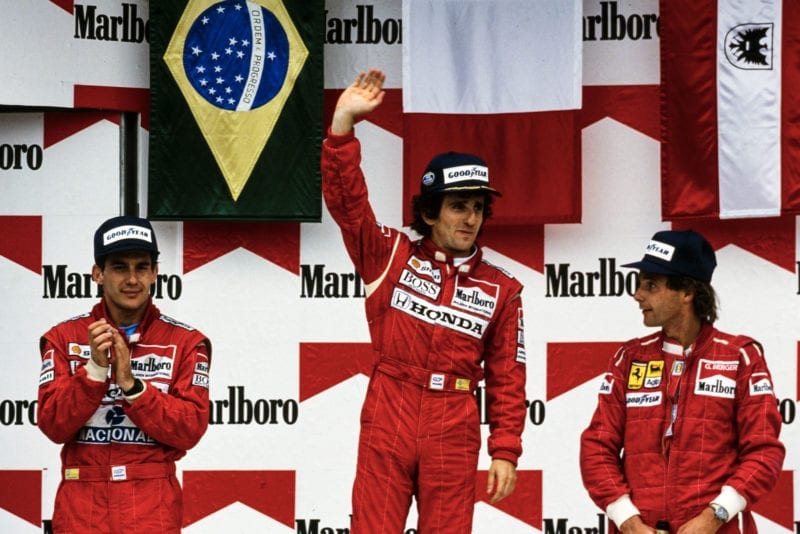
Prost celebrates another win
Motorsport Images
So could Berger have given the all-conquering McLarens aeon for their pesos? Nobody could be sure, which was what made the meeting so frustrating, but in any case the matter became academic the moment he felt obliged to ease his pace.
Nevertheless, as giant Mack and Peterbilt trucks prepared for the seven-day road haul of all the cars to Montreal, it was clear that the only driver/car combination even remotely likely to beat the Woking steamroller in the immediate future, has the number 28 on its flanks. DJT
